R. Dr. Francisco Sá Carneiro
Zona Industrial de Bouro - Letra C
4740-010 Esposende, Portugal

Cleaning large scale Solar Farms
The cleaning of large-scale solar plants is an industry that has been quickly changing its guidelines. If at first, most manufacturers did not see the need to clean the panels, later the industry became sensible to the need to clean, preferably with deionized water, and today the need for an effective cleaning of solar panels with appropriate and efficient solutions is evident, since just water may not be enough.
The accumulation of dust, bird droppings, soiling, cement dust, rust, hard water stains, and other contaminants leads to a drop in the efficiency of photovoltaic panels, and these contaminants are often not removed from the modules with a water-only cleaning.
If enhanced cleaning is not performed, it will result in a decline of the amount of energy produced and a loss of income for the asset managers/owners. The efficiency loss due to soiling is estimated to be 2-5% annually worldwide and represents losses of over 4bn € annually. In large-scale PV plants, a soiling loss of as little as 2% can be already enough to justify a cleaning.
What is the best way to clean solar panels in large-scale plants to optimize cleaning time and increase system throughput?
There is a huge range of equipment available on the market that is used for cleaning large-scale plants, from brushes to robots, to rotative brushes, all with their advantages and disadvantages and depending on the size and layout of the solar plant. A combination of all the different types of equipment can also be required to effectively clean a PV plant.
Large solar farm cleaning systems are commonly used in the cleaning of large-scale solar installations, due to the magnitude of the solar farm and the need for cleaning optimization. Farm tractors are usually the go-to equipment in the cleaning of solar farms due to the size of the installation and the width of the strings. The space between the rows is, usually, large enough for the use of this type of machinery to optimize cleaning. The most common equipment is a hydraulic driven articulated brush that is coupled to the tractor. The tractor is only used to support and bring the brush close to modules. The brush is usually self-adjusting by means of capacitive or hydraulic sensors. The length of the brush can be as little as 2m and as big as 8m.
Below we give three examples of good solutions to clean large-scale solar farms.
Sun Brush
The Sunbrush mobil is a widely known solution that is used mainly to clean ground-mounted photovoltaic systems, but it also has solutions for rooftops. It is operated hydraulically with any tractor, excavator, telescopic handler and other systems. Three elements are incorporated into the sunbrush mobil system: a joystick that ensures easy control, a rotating drip pan, and the WashTronic system, which ensures automatic level compensation even on uneven ground. The cleaning arm can be rotated up to 180°.
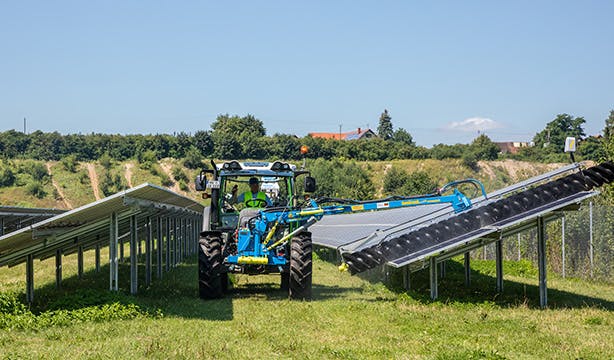

Mains Specifications:
- Quick and easy assembly
- Simple and sensitive operation
- Compact design
- Can also be used in confined spaces
- 180° rotating brush
- Wet cleaning optional with the water tank system SunBrush
- Brush from 3 to 7.5 meters wide
D2 Model by SCM – Solar Cleaning Machinery
Hydraulic arm with a self-adjusting brush for use with a tractor. It does not place any weight on the panel. The D2 is operated by tractor vehicle traction that is easily hooked up.
The equipment has the ability to work in dry and wet cleaning, overcoming any antennas or any jumping between solar modules, and puts no weight pressure on the panels. The hydraulic arm is wirelessly controlled and has adjustable sensors.
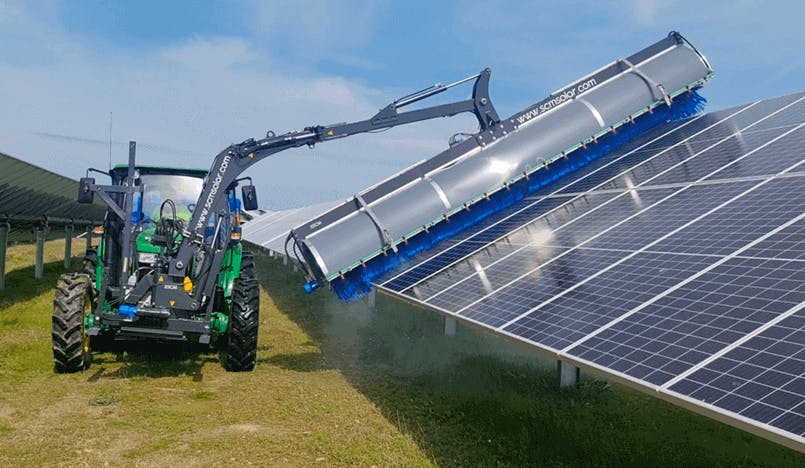
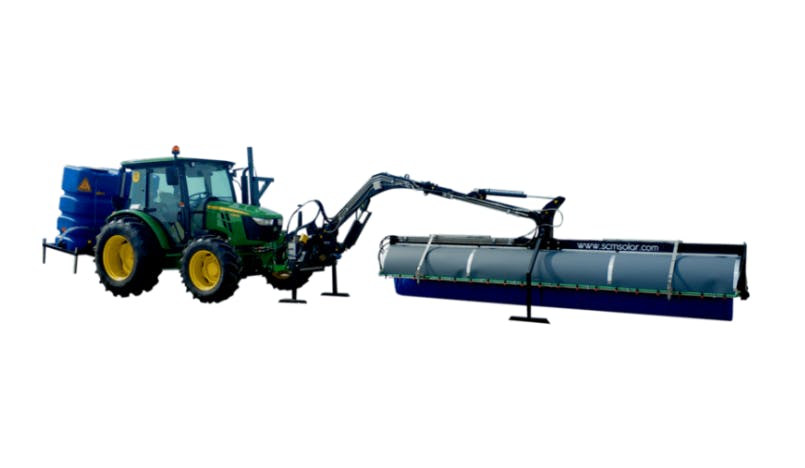
Mains Specifications:
- Quick coupling to the three-point connection
- Simple visualization of parameter setting
- Wireless joystick
- Accurate positioning on the modules
- Once the brush is positioned, the operator focuses on driving efficiency when cleaning
- Rough Terrain Regulation
- Automatic end of line
- Automatic regulation allows night work
- Does not damage the antennas
- Jump configuration
B1 by SolarCleanO
The robot can automatically follow and adapt to the height and tilt of the solar panels for smooth operation. It can be equipped with brushes of up to 6m, giving it a cleaning capacity of 8MW per day. This solution automatically adapts to the height and slope of the ground and it is possible to use the equipment in any weather condition. This robot is battery-powered.
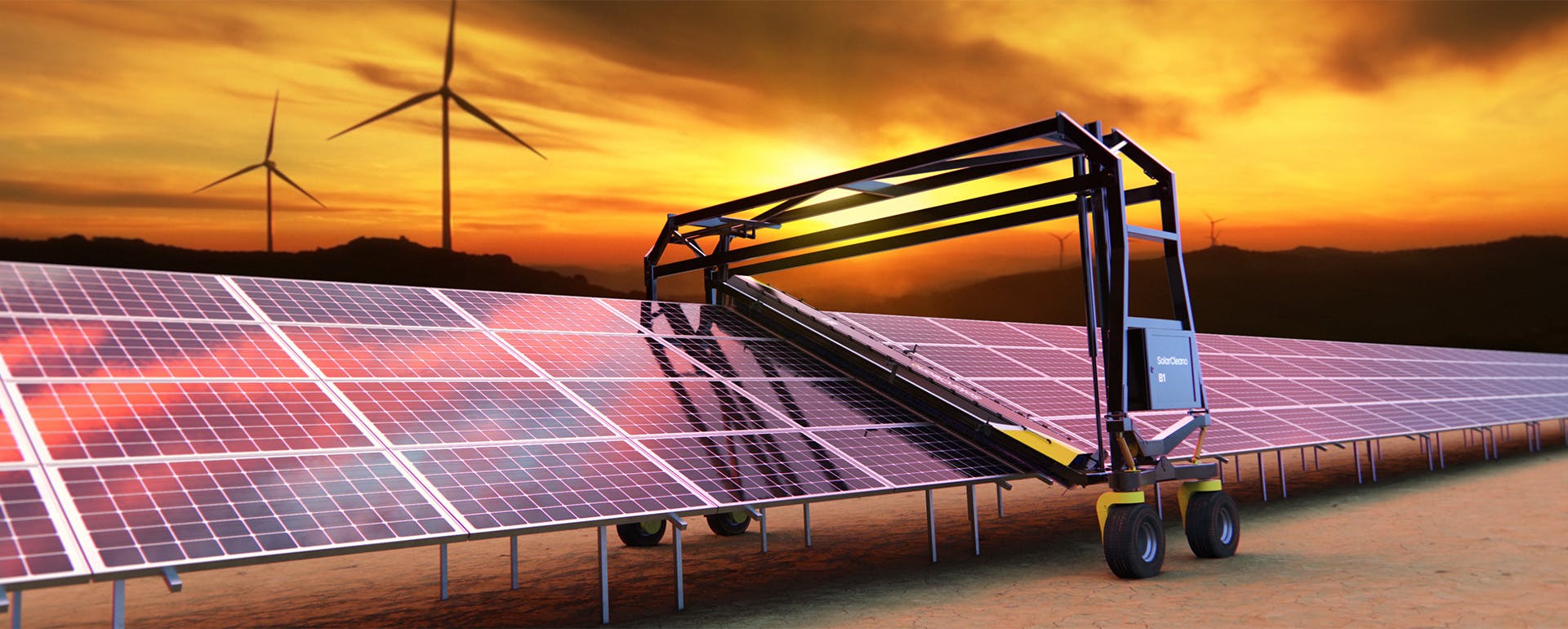
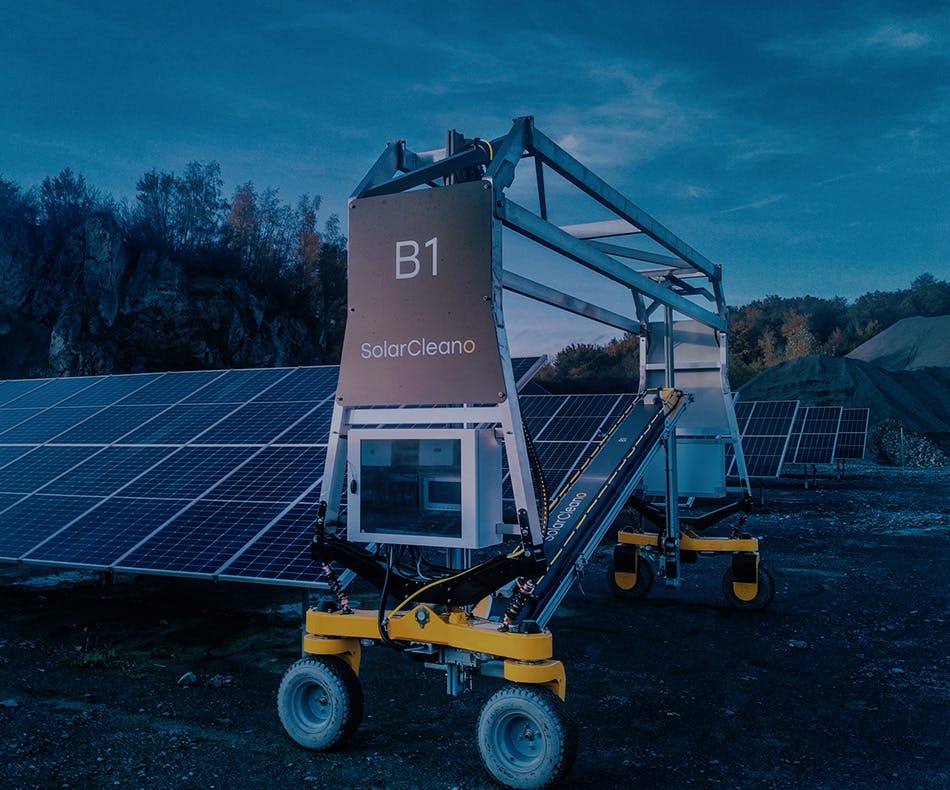
Mains Specifications:
- Remote Control-operated Robot
- For wet and dry cleaning of solar panels
- Solution for large-scale terrestrial solar farms
- Cleaning capacity up to 8MW per day
What solution can be used to clean the panels more effectively?
In order to make cleaning more effective, it is necessary to find the right cleaning solution to optimize the efficiency of the solar plant. Every PV plant is different, and you need to be prepared to tackle different layouts and terrains. If you are planning to enter the large-scale PV cleaning industry, have in mind that you will need not only the brush and the tractor but probably also a robot and a manual brush for the areas that the brush can’t reach. Have a look at our articles on robots and manual brushes if you want to know more.
As mentioned above when it comes to the location and atmospheric conditions of the solar plant, in very humid or very dry climates, located in agricultural fields, near industries (e.g. cement plants), coastal areas, among other factors, cleaning solar plants only with water will probably be inefficient, because many of the contaminants cannot be cleaned with water alone.
It is necessary in these cases to use products specific for solar panel cleaning to avoid voiding the warranty of the solar modules. These products need to be safe for all the different components of the solar modules: aluminum frame, silicone seal, glass and ARC (anti-reflective coating).
Also, have in mind that the product used should be biodegradable and environmentally friendly so as not to spoil the fauna and flora of the site.
Check out some of the solutions that will help optimize the cleanliness and energy efficiency of your solar plant.
Do you have any suggestions or topics about the solar industry you would like to read here? Reach us by email!